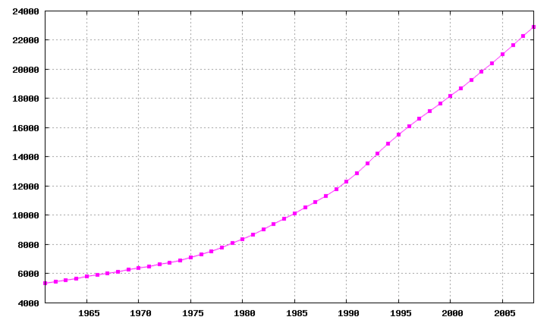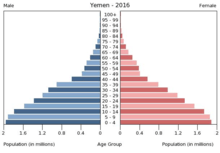Demographics of Yemen
This article is about the demographic features of the population of Yemen (Arabic: سكان اليمن), including population density, ethnicity, education level, health of the populace, economic status, religious affiliations and other aspects of the population.

Population
| Year | Pop. | ±% |
|---|---|---|
| 1950 | 4,316,000 | — |
| 1960 | 5,116,000 | +18.5% |
| 1970 | 6,145,000 | +20.1% |
| 1980 | 7,945,000 | +29.3% |
| 1990 | 11,948,000 | +50.4% |
| 2000 | 17,723,000 | +48.3% |
| 2010 | 24,053,000 | +35.7% |
| Source:[1] | ||
The population of Yemen was about 28 million according to 2018 estimates,[2][3] with 46% of the population being under 15 years old and 2.7% above 65 years. In 1950, it was 4.3 million.[4][5] By 2050, the population is estimated to increase to about 60 million.[6]
Yemenis are mainly of Arab ethnicity.[7] When the former states of North and South Yemen were established, most resident minority groups departed.[8] Yemen is still a largely tribal society.[9] In the northern, mountainous parts of the country, there are some 400 Zaidi tribes.[10] There are also hereditary caste groups in urban areas such as Al-Akhdam.[11]
According to the USCRI, Yemen hosted a population of refugees and asylum seekers numbering approximately 69 in 2007. Refugees and asylum seekers living in Yemen were predominantly from Iraq, Somalia, Ethiopia,[12] and Syria.[13]
Ethnic groups
Predominantly Arab; but also Afro-Arab, South Asians, Europeans.[14] 1,000 soldiers from France and the United States live in Yemen.[15][16]
Languages
Arabic is the official language; English is also used in official and business circles.[17] In the Mahra area (the extreme east), several non-Arabic languages (including Mehri) are spoken.[18] When the former states of north and south Yemen were established, most resident minority groups departed.[18]
Religions
Religion in Yemen consists primarily of two principal Islamic religious groups: 53% of the Muslim population is Sunni and over 45% is Shia, according to the UNHCR.[20] Other put the numbers of Shias at 30%.[17][21] Sunnis primarily adhere to the Shafi'i school, and there are also significant followers of the Maliki and Hanbali schools. Shias are primarily Zaidi and also have significant minorities of Twelver[20][22] and Ismaili Shias.[20]
Zaidis are generally found in the north and northwest and Shafi'is in the south and southeast.[18] There are also approximately 3,000 Christians and 400 Jews.[17]
Literacy
According to composite data compiled by the World Bank, the adult literacy rate for Yemen in 2005 was 35 percent for females and 73 percent for males. The overall literacy rate for the population age 15 and older was 54 percent. By comparison, low-income countries in the aggregate average an adult literacy rate of almost 62 percent.[17]
In 2006 only 75 percent of Yemen’s school-age population was enrolled in primary school; enrollment was even lower for the female population—only 65 percent. In that same year, only 37 percent of the school-age population was enrolled in secondary school, including only 26 percent of eligible females.[17]
Diaspora
The Yemeni diaspora is largely concentrated in the United Kingdom, where between 70,000 and 80,000 Yemenis live. Over 20,000 Yemenis reside in the United States, and an additional 2,812 live in Italy. Other Yemenis also reside in Saudi Arabia, the United Arab Emirates, Qatar and Bahrain, as well as Indonesia, Malaysia, Brunei, and the former USSR. A smaller number of modern-day Pakistanis are of Yemeni descent, their original ancestors having left Yemen for the Indian subcontinent and Southeast Asia over four centuries ago.[23] 350,000 Yemenite Jews live in Israel. In 2015, due to the conflict in Yemen, many have migrated to the northern coasts of Djibouti and Somalia.
Demographic statistics from the CIA World Factbook

The following demographic statistics are from the CIA World Factbook, unless otherwise indicated.[14]
Population
| Year | Population (July est.) |
Growth rate (est.) | ||||||||||
|---|---|---|---|---|---|---|---|---|---|---|---|---|
| 2004 | 20,024,867 | |||||||||||
| 2005 | 20,727,063 | |||||||||||
| 2006 | 21,456,188 | |||||||||||
| 2007 | 22,230,531 | |||||||||||
| 2008 | 23,013,376 | |||||||||||
| 2009 | 23,822,783 | |||||||||||
| 2010 | 23,495,361 | |||||||||||
| 2011 | 24,133,492 | |||||||||||
Source: CIA Factbooks 2000–2010.
| Year | Birth rate (est.): births/1000 pop. |
Death rate (est.): deaths/1000 pop. |
Net migration rate (est.): migrants/1000 pop. |
|---|---|---|---|
| 2004 | 43.16 | 8.78 | 0 |
| 2005 | 43.07 | 8.53 | 0 |
| 2006 | 42.89 | 8.30 | 0 |
| 2007 | 42.67 | 8.05 | 0 |
| 2008 | 42.42 | 7.83 | |
| 2009 | 42.14 | 7.61 | N/A |
| 2010 | 34.37 | 7.24 | N/A |
Age structure

estimates for 2010:
- 0–14 years: 43.5% (male 5,199,954/female 5,013,165)
- 15–64 years: 53.9% (male 6,438,569/female 6,233,708)
- 65 years and over: 2.6% (male 291,319/female 318,646)
Population growth rate
- 2.713% (2010 est.)
Sex ratio
(2010 est.)
- at birth: 1.05 male(s)/female
- under 15 years: 1.04 male(s)/female
- 15–64 years: 1.03 male(s)/female
- 65 years and over: 0.91 male(s)/female
- total population: 1.03 male(s)/female
Urbanization
- Urban population: 31% of total population (2008)
- Rate of urbanization: 4.9% annual rate of change (2005–2010 est.)
AIDS adult prevalence rate
- 0.1% (2001 est.)
HIV/AIDS – people living with HIV/AIDS
- 12,000 (2001 est.)
HIV/AIDS – deaths
N/A
Life expectancy at birth
(2010 est.)
- total population: 63.36 years
- male: 61.35 years
- female: 65.47 years
Major infectious diseases
- degree of risk: high
- food or waterborne diseases: bacterial diarrhea, hepatitis A, and typhoid fever
- vectorborne diseases: dengue fever and malaria
- water contact disease: schistosomiasis (2009)
Nationality
- noun: Yemeni(s)
- adjective: Yemeni
Vital statistics
In 2007 the birthrate and death rate were estimated to be 42.7 per 1,000 and 8.1 per 1,000, respectively (CIA est.). The infant mortality rate was almost 58 deaths per 1,000 live births. The rate was estimated to be higher for males than for females—more than 62 male deaths per 1,000 live births, as compared with about 53 female deaths per 1,000 live births. Despite an increase of 14 years in the last decade, life expectancy at birth in Yemen has remained low compared with other developing countries—60.6 years for males and 64.5 years for females, or 62.5 years overall. The country’s fertility rate was almost 6.5 children per woman in 2007 free.[17]
UN estimates[24]
| Period | Live births per year | Deaths per year | Natural change per year | CBR1 | CDR1 | NC1 | TFR1 | IMR1 |
|---|---|---|---|---|---|---|---|---|
| 1950–1955 | 214,000 | 131,000 | 84,000 | 47.6 | 29.0 | 18.6 | 7.27 | 215.1 |
| 1955–1960 | 234,000 | 133,000 | 101,000 | 47.8 | 27.1 | 20.7 | 7.28 | 204.2 |
| 1960–1965 | 261,000 | 138,000 | 123,000 | 48.6 | 25.6 | 22.9 | 7.34 | 194.0 |
| 1965–1970 | 296,000 | 144,000 | 152,000 | 50.3 | 24.5 | 25.8 | 7.52 | 184.4 |
| 1970–1975 | 329,000 | 149,000 | 180,000 | 51.2 | 23.2 | 28.0 | 7.67 | 174.4 |
| 1975–1980 | 410,000 | 144,000 | 266,000 | 56.0 | 19.7 | 36.3 | 8.58 | 143.2 |
| 1980–1985 | 512,000 | 140,000 | 373,000 | 57.9 | 15.8 | 42.1 | 9.23 | 113.5 |
| 1985–1990 | 585,000 | 137,000 | 448,000 | 53.9 | 12.6 | 41.3 | 8.93 | 94.0 |
| 1990–1995 | 665,000 | 155,000 | 510,000 | 49.1 | 11.4 | 37.6 | 8.24 | 86.2 |
| 1995–2000 | 702,000 | 167,000 | 535,000 | 42.7 | 10.2 | 32.6 | 6.98 | 78.6 |
| 2000–2005 | 765,000 | 159,000 | 605,000 | 39.9 | 8.3 | 31.5 | 6.10 | 64.8 |
| 2005–2010 | 864,000 | 156,000 | 708,000 | 38.6 | 7.0 | 31.7 | 5.48 | 53.3 |
| 1 CBR = crude birth rate (per 1000); CDR = crude death rate (per 1000); NC = natural change (per 1000); TFR = total fertility rate (number of children per woman); IMR = infant mortality rate per 1000 births | ||||||||
Births and deaths [25]
| Year | Population (x1000) | Live births | Deaths | Natural increase | Crude birth rate | Crude death rate | Rate of natural increase | TFR |
|---|---|---|---|---|---|---|---|---|
| 2010 | 318,936 | 28,494 | 290,422 | |||||
| 2011 | 239,980 | 23,622 | 216,358 | |||||
| 2012 | 279,719 | 28,596 | 251,123 | |||||
| 2013 | 425,165 | 35,066 | 390,099 |
Fertility and births
Total Fertility Rate (TFR) (Wanted Fertility Rate) and Crude Birth Rate (CBR):[26]
| Year | CBR (Total) | TFR (Total) | CBR (Urban) | TFR (Urban) | CBR (Rural) | TFR (Rural) |
|---|---|---|---|---|---|---|
| 1997 | 39.2 | 6.48 | 35.2 | 5.01 | 40.6 | 7.03 |
| 2013 | 33.4 | 4.4 (3,1) | 27.4 | 3.2 (2,4) | 36.2 | 5.1 (3,5) |
Life expectancy
| Period | Life expectancy in Years |
Period | Life expectancy in Years |
|---|---|---|---|
| 1950–1955 | 34.7 | 1985–1990 | 56.8 |
| 1955–1960 | 34.7 | 1990–1995 | 58.5 |
| 1960–1965 | 34.7 | 1995–2000 | 59.8 |
| 1965–1970 | 39.1 | 2000–2005 | 61.0 |
| 1970–1975 | 43.3 | 2005–2010 | 62.8 |
| 1975–1980 | 48.1 | 2010–2015 | 64.2 |
| 1980–1985 | 53.0 |
Source: UN World Population Prospects[27]
See also
- Tribes in Yemen
References
- World Population Prospects: The 2010 Revision
- ""World Population prospects – Population division"". population.un.org. United Nations Department of Economic and Social Affairs, Population Division. Retrieved November 9, 2019.
- ""Overall total population" – World Population Prospects: The 2019 Revision" (xslx). population.un.org (custom data acquired via website). United Nations Department of Economic and Social Affairs, Population Division. Retrieved November 9, 2019.
- "The General Census of Population 2004". Sabanews. 29 December 2004 [Updated 13 December 2013]. Retrieved 13 December 2013.
- "The population explosion on Europe's doorstep". Times (London). London. 18 May 2008. Retrieved 22 February 2013. (subscription required)
- "Yemen: Government planning to curb population growth". IRIN Middle East. 14 July 2008. Retrieved 22 February 2013. (for Arabic, read it here: .)
- "Yemen". Central Intelligence Agency. CIA World Factbook. 6 December 2013.
- "U.S. Relations With Yemen". U.S. Department of State. 28 August 2013.
- Flamand, Annasofie; Macleod, Hugh (5 December 2009). "The children of Yemen's tribal war". The Herald Scotland. Glasgow. Retrieved 22 February 2013.
- Pike, John (5 July 2011). "Zaydi Islam". Globalsecurity.org. Retrieved 22 February 2013. (Requires 3rd-party cookies)
- Lehmann, Hermann (1954). "Distribution of the sickle cell trait". Eugenics Review. 46 (2): 101–121. PMC 2973326. PMID 21260667.
- "World Refugee Survey 2008". U.S. Committee for Refugees and Immigrants. 19 June 2008. Archived from the original on 19 October 2014. Retrieved 13 December 2013.
- "Poor and desperate, Syrian refugees beg on Yemen's streets". Reuters. 26 September 2013. Retrieved 13 December 2013.
- The World Factbook - Yemen
- https://www.dailysabah.com/mideast/2018/06/16/french-troops-fighting-houthis-in-yemen-alongside-uae-forces-le-figaro-claims
- https://www.independent.co.uk/news/world/americas/us-politics/us-special-forces-saudi-arabia-yemen-war-green-berets-houthi-rebels-mohammed-bin-salman-a8335481.html
- Country profile: Yemen. Library of Congress Federal Research Division (August 2008).

- Background note: Yemen. US Department of State (December 2007).

- "Middle East :: YEMEN". CIA The World Factbook.
- "Yemen: The conflict in Saada Governorate – analysis". UN High Commissioner for Refugees. 24 July 2008. Archived from the original on 2012-11-20. Retrieved 2 January 2014.
- Merrick, Jane; Sengupta, Kim (20 September 2009). "Yemen: The land with more guns than people". The Independent. London. Retrieved 21 March 2010.
- Al-Zaidi, Hassan (22 October 2007). "The Twelve-Imam Shiite Sect". Yemen Times. Archived from the original on 22 October 2007.
- Yemenis in the UK
- World Population Prospects: The 2010 Revision Archived May 6, 2011, at the Wayback Machine
- http://unstats.un.org/unsd/demographic/products/dyb/dyb2014.htm
- http://www.dhsprogram.com/pubs/pdf/FR94/FR94.pdf
- "World Population Prospects – Population Division – United Nations". Retrieved 2017-07-15.
